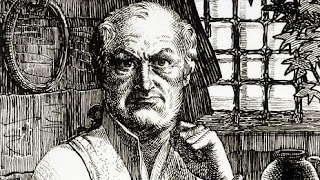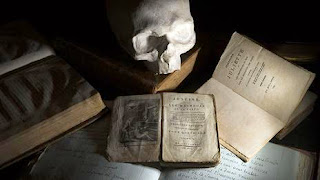"Either kill me or take me like this, for I will not change," wrote the imprisoned Marquis de Sade to his wife in 1783. It could only be one or the other for the most extreme author of the 18th Century. Sade, an unstoppable libertine, was in the middle of what would be an 11-year prison sentence, but he would not recant his principles or his tastes to get out of jail. Any diversion from his true nature was, for the marquis, equivalent to death.
Sade, rediscovered but still widely misunderstood, is the subject of two exhibitions in Paris that offer a new chance to rediscover one of the most darkly influential figures of European culture. Later this month the Musée d'Orsay opens Sade: Attacking the Sun, an ambitious new exhibition that rereads the history of modern art through the lens of his radical writings. Just around the corner, the Musée des Lettres et Manuscrits is presenting an exhibition of Sade's letters and books, including the manuscript for his audacious and stomach-turning novel The 120 Days of Sodom. Both should allow viewers to think more deeply about Sade's time and ours, and how thoroughly the one informs the other.
Our story of the 18th Century – not just in France but also in its fellow child of the age, the United States – can sometimes be a little one-sided, a little deceptive. The Enlightenment has come to mean reason, rationality, science, humanism, but that was never the whole story of the era. Sade, who died two hundred years ago this December, is unquestionably an Enlightenment figure. He greatly admired Rousseau, an author his jailers refused to let him read. Yet he struck the first blow (and Sade would like that metaphor) against the primacy of reason and rationality, and in favour of rebellion, extremity, and anti-humanism. Those are themes that scandalized the great and the good of the period, but they have resounded through the art, literature, and philosophy of the last two centuries.
Vice principle
Donatien Alphonse François de Sade, born in 1740, was a hugely complicated person. He was an aristocrat, but also a hard-left figure and delegate to the National Convention during the French Revolution who renounced his title during the Reign of Terror. He wrote some of the most provocative novels ever composed, but also bland and conventional plays that were not at all obscene. And of course, he had a marked taste for rougher forms of sexual intercourse: practices which now bear his name, but which an even cursory study of 18th-Century literature shows, were not exactly unique for the time. As Michel Foucault, the great historian of sexuality, once observed, sadism is not "a practice as old as Eros," but rather "a massive cultural fact which appeared precisely at the end of the eighteenth century."
Like Voltaire and Rousseau before him, Sade wrote novels that had to be read in two ways at once: as entertainments, but also as philosophical treatises. Even at his most outrageous, Sade was not really a pornographic writer. His early 120 Days of Sodom, with its endless lists of slicings, fractures, immolations, exsanguinations and death, offers no sexual titillation at all. Even his best novel, Justine, featuring a libertine priest defiling a girl with a strategically inserted communion wafer, scandalised French society not for any pornographic excess, but for its pitch-black moral vision – in which abusing other humans is not just acceptable but positively virtuous. Sade took Immanuel Kant's categorical insistence that humans must do their duty and turned it on its head. True morality, for Sade, entailed following your darkest and most destructive passions to their farthest possible ends, even at the expense of other human life. (The whips are for beginners: Sade had no particular problem with murder, though he was an unsparing opponent of the death penalty. To kill a man in passion was one thing, but to rationalise killing by law was barbarous.)
The manuscript of The 120 Days of Sodom written by the Marquis de Sade while he was imprisoned at the Bastille in 1785 (Martin Bureau/AFP/Getty Images)
"We rail against the passions," he wrote, "but never think that it is from their flame that philosophy lights its torch." For Sade, vile and cruel desires are not aberrations. They are fundamental, even constitutive aspects of human nature. And what is more, said Sade, those faculties of reason that Enlightenment thinkers held in such high esteem are only a byproduct of these deep-seated desires: humans are governed by these desires far more than by any rational impetus. Nobility is a fraud. Cruelty is natural. Immorality is the only morality, vice the only virtue.
Bad influence?
Sade did just not write excessively –he lived excessively, and for his troubles he spent a third of his life in prisons, including at the Bastille in 1789, or in insane asylums. ("The entr'actes of my life have been too long," he wrote in one of his notebooks.) His books were banned soon after his death in 1814. But while Sade's writings hibernated, his dark moral vision spread. Francisco Goya, when we wasn't painting subtly satirical portraits of the Spanish royal family, devoted himself to demented sequences of prints – the Caprichos, the Disasters of War, the late Dreams – in which cruelty triumphed over virtue and meaninglessness won out over rationality. "The sleep of reason produces monsters," reads the caption of his most famous print: a dozing man, perhaps the artist himself, haunted by nightmarish beasts. Foucault saw Goya's etchings, especially the grim and satirical Caprichos, as the natural counterpart of Sade's writings. In both, he claimed, "the western world received the possibility of transcending its reason in violence…. After Sade and Goya, unreason has belonged to whatever is decisive for the modern world."
Did Sade's writing influence other works such as Francisco Goya's dark sequence of prints, the Caprichos series? (Wikipedia)
Though Sade's visions of humans beyond reason and of bodies in extreme states ripple through the work of many other artists of the early 19th Century, especially Eugène Delacroix and Théodore Géricault, his actual writings were little known. Only toward the end of the century was the 'divine marquis' truly rediscovered. For some, it's true, he offered a chance to give their sexual indulgences a little literary cred. (The Victorian poet Charles Swinburne, who worshipped Sade, wrote under a pseudonym long and utterly tedious mock-epic poetry about boys being flogged.) But the greatest writers of the age saw Sade as something much more important: a philosopher of a world turned upside down.
Sade's books were banned soon after his death in 1814 (Mary Evans Picture Library/Alamy)
"I am the wound and yet the blade! / The smack, and yet the cheek who takes it!" wrote Charles Baudelaire in The Flowers of Evil, one of the earliest texts to bring Sadean principles back into literature. Friedrich Nietzsche, whose sex life was as closed down as Sade's was exposed, clearly owes a major debt to the marquis. Guillaume Apollinaire, the poet who coined the word surrealism, also edited the first complete volume of Sade's writings – and many other surrealists looked to Sade's writings, whose scenes of sex and violence are often anatomically impossible, as an early inspiration.
But not only them. Joseph Conrad's Heart of Darkness, featuring a colonial administrator gone mad in the Congo, is essentially a Sadean novel. So is Death in Venice, Thomas Mann's decadent masterpiece of a professor whose only true desires are taboo. It is hard to imagine Sigmund Freud without Sade, who placed libido at the heart of human nature a century in advance. And while Pier Paolo Pasolini, who adapted 120 Days of Sodom into the nearly unwatchable Salò, was Sade's greatest cinematic student, his influence is visible in widely divergent film traditions, from Nagisa Oshima's stately In the Real of the Senses to John Waters's trash films of the 1980s.
Still scaring us? A moulding of the Marquis de Sade's skull, made in 1820 (Joel Saget/AFP/Getty Images)
He is everywhere, and still he scares us. Why? Because with Sade, no cold or objective analysis is possible; the body is implicated as much as the mind, and reason has to be subordinated to deeper, scarier impulses. Even his alleged admirers find that too much to bear – in Philip Kaufman's 2000 film Quills, starring Geoffrey Rush, Sade had to be sanitised into a martyr for pat, liberal, law-abiding freedom of expression (complete with a ridiculous and totally fictional mutilation sequence; in fact, Sade died peacefully). What Sade stands for, though, is not liberty but extremity. He is the prophet of a world exceeding its boundaries. And in a world now pushing political, economic, and ecological limits to the breaking point, his dark vision of humanity looks increasingly, chillingly credible.
If you would like to comment on this story or anything else you have seen on BBC Culture, head over to our Facebook page or message us on Twitter.
| Evernote helps you remember everything and get organized effortlessly. Download Evernote. |




No comments:
Post a Comment